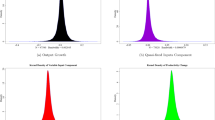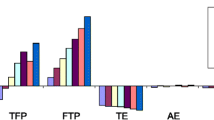Abstract
This article investigates the sources and determinants of output growth of Italian manufacturing firms. Applying stochastic frontier techniques, we decompose output growth into factor accumulation and TFP growth for the period 1998–2003. TFP growth is further decomposed into technological change, efficiency change and scale effects. Two key results emerge from the analysis. After confirming that both input accumulation and TFP growth are important in explaining output growth, we show that efficiency change (technological catch-up) is the most significant component of TFP growth in explaining output growth distribution. Furthermore, using a specific model of the asymmetric error component, we find that R&D spillovers, banking efficiency and public infrastructures have statistically significant and economically relevant effects on technological catch-up.
Similar content being viewed by others
References
Aigner D, Chu S (1968) On estimating the industry production function. Am Econ Rev 58(4): 826–839
Aigner D, Lovell CAK, Schmidt P (1977) Formulation and estimation of stochastic frontier production function models. J Econom 6(1): 21–37
Aiello F, Cardamone P (2008) R&D Spillovers and firms’ performance in Italy. Evidence from a flexible production function. Empir Econ 34(1): 143–166
Aiello F, Scoppa V (2000) Uneven regional development in Italy: explaining differences in productivity levels. Giornale degli Economisti e Annali di Economia 59(2): 270–298
Aschauer DA (1989) Does public capital crowd out private capital?. J Monet Econ 24(2): 178–235
Badunenko O, Henderson DJ, Zelenyuk V (2008) Technologicl change and transition: relative contributions to worldwide growth during the 1990s. Oxford Bull Econ Stat 70(4): 461–492
Balk BM (2003) The residual: on monitoring and benchmarking firms, industries, and economies with respect to productivity. J Prod Anal 20(1): 5–47
Baltagi BH, Pinnoi N (1995) Public capital stock and state productivity growth: further evidence from an error components model. Empir Econ 20(2): 351–359
Bank of Italy (2006) Considerazioni finali. Relazione sull’anno 2005. Rome
Barro RJ (1990) Government spending in a simple model of endogenous growth. J Political Econ 98(5): S103–S125
Battese GE, Coelli TJ (1995) A model for technical inefficiency effects in a stochastic frontier production function for panel data. Empir Econ 20(2): 325–332
Becker GS (1975) Human capital, 2nd edn. National Bureau of Economic Research and Columbia University Press, New York
Benhabib J, Spiegel MM (1994) The role of human capital in economic development. Evidence from aggregate crosscountry data. J Monet Econ 34(2): 143–173
Bonaglia F, La Ferrara E, Marcellino M (2000) Public capital and economic performance: evidence from Italy. Giornale degli Economisti e Annali di Economia 59(2): 221–244
Bronzini R, Piselli P (2006) Determinants of lung-run regional productivity: the role of R&D, human capital and public infrastructure. Temi di Discussione Banca d’Italia No. 597
Charnes A, Cooper W, Rhodes E (1978) Measuring the efficiency of decision making units. Eur J Oper Res 2(6): 429–444
Ciccone A (2004) Human capital as a factor of growth and employment at the regional level: the case of Italy. Report for the European Commission, DG for Employment and Social Affairs
Coelli T, Rao DSP, Battese GE (1998) An introduction to efficiency and productivity analysis. Kluwer Academic Publishers, Boston, Dordrecht, London
Daveri F, Jona-Lasinio C (2005) Italy’s decline: getting the facts right. Giornale degli Economisti e Annali di Economia 64(4): 365–410
Destefanis S (2000) Differenziali territoriali di produttività ed efficienza e sviluppo dualistico. Lavoro e relazioni industriali 7(2): 103–143
Destefanis S, Sena V (2005) Public infrastructure and total factor productivity: new evidence from Italian Regions, 1970-98. Reg Stud 39(5): 603–617
Di Liberto A, Pigliaru F, Mura R (2008) How to measure the unobservable: a panel technique for the analysis of TFP convergence. Oxford Econ Pap 60(2): 343–368
Faini R, Haskel J, Barba Navaretti G, Scarpa C, Wey C (2005) Contrasting Europe’s decline: do product market reforms help? Paper presented at the conference “Oltre il declino”, Fondazione Rodolfo De Benedetti, February 2005 (revised July)
Fan Y, Ullah A (1999) On goodness-of-fit tests for weakly dependent processes using kernel method. J Nonparametric Stat 11(3): 337–360
Fare R, Grosskopf S, Norris M, Zhang Z (1994) Productivity growth, technical progress, and efficiency change in industrialized countries. Am Econ Rev 84(1): 66–83
Greene WH (1990) A gamma-distributed stochastic frontier model. J Econom 46(1-2): 141–164
Greenwood J, Jovanovic B (1990) Financial development, growth, and the distribution of income. J Political Econ 98(5): 1076–1107
Griliches Z (1979) Issues in assessing the contribution of R&D to productivity growth. Bell J Econ 10(1): 92–116
Grossman G, Helpman E (1991) Innovation and growth in the global economy. MIT Press, Cambridge, MA
Guiso L, Sapienza P, Zingales L (2004) Does local financial development matter?. Q J Econ 119(3): 929–969
Henderson DH, Kumbhakar SC (2006) Public and private capital productivity puzzle: a nonparametric approach. Southern Econ J 73(1): 219–232
Hicks J (1969) A theory of economic history. Clarendon Press, Oxford
Holtz-Eakin D (1994) Public-sector capital and the productivity puzzle. Rev Econ Stat 76(1): 12–21
ISTAT (2004) La produttivit totale dei fattori. Anni 1993–2003. Rome
ISTAT (2005) Regional economic accounts (Conti Economici Regionali: 1980–2004). Rome
Jayaratne J, Strahan PE (1996) The finance-growth nexus: evidence from bank branch deregulation. Q J Econ 111(3): 639–670
Jorgenson DW (1990) Productivity and economic growth. In: Berndt ER, Triplett JE (eds) Fifty years of economic measurement, studies in income and wealth, vol 54. National Bureau of Economic Research, Chicago
King RG, Levine R (1993a) Finance and growth: Schumpeter might be right. Q J Econ 108(3): 717–737
King RG, Levine R (1993b) Finance, entrepreneurship, and growth. J Monet Econ 32(3): 513–542
Kodde D, Palm F (1986) Wald criteria for jointly testing equality and inequality restrictions. Econometrica 54(5): 1243–1248
Koetter M, Wedow M (2006) Finance and growth in a bank-based economy: is it quantity or quality that matters?. Deutsche Bank Discussion paper No. 2
Krugman P (1987) The narrow moving bank, The Dutch disease and the competitive consequences of Mrs. Thatcher: notes on trade in the presence of dynamic scale economies. J Dev Econ 27(1-2): 41–55
Kumar S, Russell RR (2002) Technological change, technological catch-up, and capital deepening: relative contributions to growth and convergence. Am Econ Rev 92(3): 527–548
Kumbhakar SC, Ghosh S, McGuckin JT (1991) A generalized production frontier approach for estimating determinants of inefficiency in US dairy farms. J Bus Econ Stat 9(3): 279–286
Kumbhakar SC, Lovell CAK (2000) Stochastic frontier analysis. Cambridge University Press, Cambridge
La Ferrara E, Marcellino M (2005) TFP, costs, and public infrastructure: an equivocal relationship. In: Artis M, Banerjee A, Marcellino M (eds) The central and eastern European countries and the European Union. Cambridge University Press, Cambridge
La Porta R, Lopez-de-Silanes F, Shleifer A, Vishny RW (1998) Law and finance. J Political Econ 106(6): 1113–1155
Levine R (1999) Law, finance, and economic growth. J Financ Intermed 8(1-2): 36–67
Levine R (2005) Finance and growth: theory and evidence. In: Philippe A, Steven D (eds) Handbook of economic growth. Elsevier Science, Amsterdam, The Netherlands
Levine R, Loayza N, Beck T (2000) Financial intermediation and growth: causality and causes. J Monet Econ 46(1): 31–77
Li Q (1996) Nonparametric testing of closeness between two unknown distribution functions. Econom Rev 15(3): 261–274
Lovell CAK (1993) Production frontiers and production efficiency. In: Fried HO, Lovell CAK, Schmidt SS (eds) The measurement of productive efficiency. Oxford University Press, Oxford
Lucas RE Jr (1988) On the mechanics of economic development. J Monet Econ 22(1): 3–42
Lucchetti R, Papi L, Zazzaro A (2001) Banks’ inefficiency and economic growth: a micro-macro approach. Scottish J Political Econ 48(4): 400–424
Maffezzoli M (2006) Convergence across Italian regions and the role of technological catch-up. Top Macroecon 6(1) (Article 15)
Malerba F (2004) Sectoral systems of innovation: how and why innovation differs across sectors. In: Fagerber J, Mowery D, Nelson R (eds) Handbook of innovation. Cambridge University Press, Cambridge
Manning MJ (2003) Finance causes growth: can we be so sure?. Contributions Macroecon 3(1): 1–22
Marrocu E, Paci R (2010) The effects of public capital on the productivity of the Italian regions. Appl Econ 42(8): 989–1002
Mastromarco C (2007) New evidence on the sources of OECD productivity growth, Working Paper, University of Salento, Italy
Mastromarco C, Woitek U (2006) Public infrastructure investment and efficiency in Italian regions. J Prod Anal 25(1-2): 57–65
Morrison CJ, Schwartz AE (1996) State infrastructure and productive performance. Am Econ Rev 86(5): 1095–1111
Munnel AH (1992) Policy watch: infrastructure investment and economic growth. J Econ Persp 6(4): 189–198
Nadiri MI, Mamuneas TP (1994) The effects of public infrastructure and R&D capital on the cost structure and performance of U.S. manufacturing industries. Rev Econ Stat 76(1): 22–37
OECD (2007) OECD Economic Surveys: Italy, Paris (ISBN 978-92-64-033324-5)
Parente S, Prescott E (2004) A unified theory of the evolution of international income levels. Federal Reserve Bank of Minneapolis Staff Report, 333
Pavitt K (1984) Sectoral patterns of technical change: towards a taxonomy and a theory. Res Policy 13(6): 343–373
Picci L (1999) Productivity and infrastructure in the Italian regions. Giornale degli Economisti e Annali di Economia 58(3–4): 329–353
Quah DT (1996) Empirics for economic growth and convergence. Eur Econ Rev 40(6): 1353–1375
Reifschneider D, Stevenson R (1991) Systematic departures from the frontier: a framework for the analysis of firm efficiency. Int Econ Rev 32(3): 715–723
Romer PM (1986) Increasing returns and long-run growth. Journal Political Econ 94(5): 1002–1037
Schumpeter J (1934) The theory of economic development. Harvard University Press, Cambridge, MA
Sena V (2006) The determinants of firms’ performance: can finance constraints improve technical efficiency?. Eur J Oper Res 172(1): 311–325
Simar L, Wilson PW (1998) Sensitivity analysis of efficiency scores: how to bootstrap in nonparametric frontier models. Manag Sci 44(1): 49–61
Simar L, Wilson PW (2000) A general methodology for bootstrapping in non-parametric frontier models. J Appl Stat 27(6): 779–802
Tallman E, Wang P (1994) Human capital and endogenous growth: evidence from Taiwan. J Monet Econ 34(1): 101–124
Timmer C (1971) Using a probabilistic frontier production function to measure technical efficiency. J Political Econ 79(4): 776–794
van Ark B, O’Mahony M, Ypma G (eds) (2007) The EU KLEMS productivity report, WP2007-1. Policy Support and Anticipating Scientific nd Technologiacal Neeeds, European Commision
van den Broeck J, Koop G, Osiewalski J, Steel MFJ (1994) Stochastic frontier models: a bayesian perspective. J Econom 61(2): 273–303
Zago A, Dongili P (2010) Credit quality and technical efficiency in banking. Empirical Economics. doi:10.1007/s00181-010-0343-1
Author information
Authors and Affiliations
Corresponding author
Rights and permissions
About this article
Cite this article
Aiello, F., Mastromarco, C. & Zago, A. Be productive or face decline. On the sources and determinants of output growth in Italian manufacturing firms. Empir Econ 41, 787–815 (2011). https://doi.org/10.1007/s00181-010-0405-4
Received:
Accepted:
Published:
Issue Date:
DOI: https://doi.org/10.1007/s00181-010-0405-4
Keywords
- Growth accounting
- Stochastic frontiers
- TFP
- R&D spillovers
- Banking efficiency
- Infrastructure
- Italian manufacturing firms




